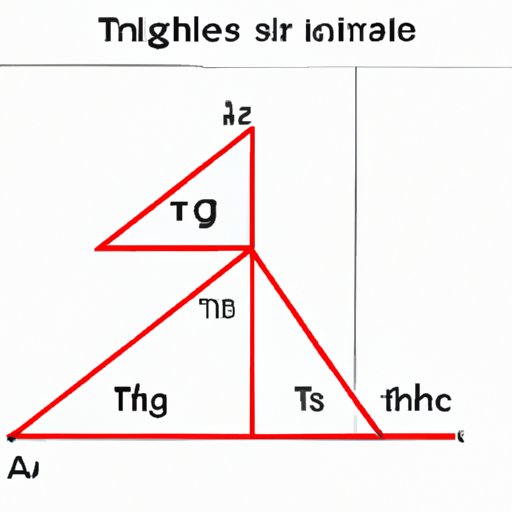I. Introduction
When it comes to solving problems related to geometry, one of the most challenging ones is determining the possible side lengths of a triangle. This is a pivotal aspect in a wide range of fields, including architecture, physics, engineering, and other related professions. It is essential to find out the side lengths that can create a triangle before proceeding with other analysis and calculations. In this article, we will provide you with a comprehensive guide on how to find the possible side lengths of a triangle using various techniques.
II. Understanding the Triangle Inequality Theorem
The Triangle Inequality Theorem is a fundamental principle that governs all triangles. The theorem states that the sum of the two shortest sides of a triangle should be greater than the longest side. If this condition is not met, then a triangle cannot be formed. In other words, the length of one side of a triangle should always be less than the sum of the other two sides.
To use this theorem, start by determining the longest side of a potential triangle. Then, identify which two sides are the shortest. Add the two shortest sides and compare them to the length of the longest side. If the sum of the two shortest sides is less than the longest side, a triangle cannot be formed with those side lengths.
III. The Geometric Interpretation of the Pythagorean Theorem and Its Application to Triangles
The Pythagorean Theorem is one of the most well-known mathematical equations. It is applicable in finding the missing side of a right triangle. The theorem states that in a right-angled triangle, the square of the hypotenuse (the longest side) is equal to the sum of the squares of the other two sides. The geometric interpretation of the theorem shows how the three sides of a right triangle relate to each other.
To use the Pythagorean Theorem to find the missing side of a right triangle, identify the two sides that make up the right angle and label them as a and b. The hypotenuse will be labeled as c. Use the equation c²=a²+b² to find the length of the missing side. For example, if a = 3 and b = 4, then c can be found by applying the Pythagorean Theorem:
c² = 3² + 4²
c² = 9 + 16
c² = 25
c = √25
c = 5
IV. Sine, Cosine, and Tangent Functions: How to Use Them to Determine Triangle Side Lengths
The sine, cosine, and tangent functions are used to find missing side lengths in any triangle. Each of these functions is based on the ratios of the sides of a right triangle. The sine function represents the ratio of the length of the side opposite an angle to the length of the hypotenuse. The cosine function represents the ratio of the length of the adjacent side to the length of the hypotenuse. Finally, the tangent function represents the ratio of the length of the opposite side to the length of the adjacent side.
To apply these functions, you need to know at least two side lengths and one angle of a triangle. For example, if you know that one angle is 30 degrees and the adjacent side (a) measures 3, you can find the hypotenuse (c) using the cosine function:
cos(30) = a/c
c = a/cos(30)
c = 3/0.866
c = 3.464
V. The Law of Cosines: A Comprehensive Guide to Finding All Side Lengths of Any Triangle
The Law of Cosines is a formula that can be used to find all three sides of any triangle, regardless of whether it is a right triangle or not. The formula states that the square of one side of a triangle is equal to the sum of the squares of the other two sides minus twice the product of the two sides times the cosine of the angle between them.
To apply the Law of Cosines, identify which side you want to find and which angles and sides are known. Plug them into the formula and solve for the unknown. For example, given a triangle with sides a, b, and c, and angles A, B, and C, if you want to find side c, you can use the formula:
c² = a² + b² – 2ab cos(C)
VI. Special Right Triangles: Using Relationships Between Side Lengths to Solve for Unknowns
Special right triangles are triangles that have specific relationships between their side lengths. These include the 45-45-90 and 30-60-90 triangles. The 45-45-90 triangle has two angles of equal measure (45 degrees) and its sides are in the ratio of 1:1:√2. The 30-60-90 triangle has angles of 30, 60, and 90 degrees and its sides are in the ratio of 1: √3: 2.
To use these relationships to find missing side lengths, identify which type of special triangle is involved. Then, use the corresponding ratio of side lengths to find the missing side. For example, if you have a 45-45-90 triangle with one leg measuring 10, then the other leg and hypotenuse can be found using the ratios:
Leg = hypotenuse/√2
Leg = 10/√2
Leg = 7.07
VII. Real-life Applications of Triangle Side Lengths: Examples from Architecture, Engineering, and Physics
Triangle side lengths are used in various professions, as they are essential in analyzing and designing structures. Architecture, engineering, physics, and other fields use triangles to calculate the safe load-bearing capacity of structures such as bridges, buildings, and towers. They are also used to calculate various measurements, including angles and distances.
VIII. Conclusion
Determining possible side lengths of a triangle can be a challenging task, but having a solid understanding of the concepts regarding triangles and their relationships can make solving these problems more manageable. In conclusion, this article has provided a comprehensive guide to several techniques and formulas you can use to find side lengths of any triangle. We hope this guide has provided you with the necessary knowledge to tackle any triangle problem that comes your way.
